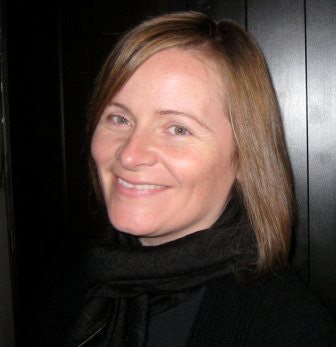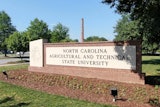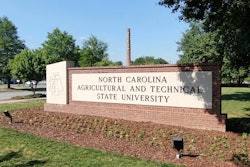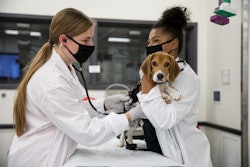 Danni Redding Lapuz, project director of the STEM Center at Cañada College, said the center was created to eliminate redundancies in programs and make them more accessible to students.
Danni Redding Lapuz, project director of the STEM Center at Cañada College, said the center was created to eliminate redundancies in programs and make them more accessible to students.
That’s how the STEM Center was created.
“We decided to design a structure on our campus that would be an umbrella for all the different programs and funding sources that come and go that create longevity in support services,” says Danni Redding Lapuz, project director of the now two-year-old STEM Center.
In 2011, the college created the STEM Center, an all-encompassing center that consolidated various programs and STEM-related offerings under one roof. The college was awarded a $6 million grant from the Department of Education simultaneously in 2011 for the one-stop-shop, further bolstering resources at the center.
At the center, faculty can learn how to get funding for projects or organize field trips or events, and students receive STEM-related counseling and support services. The school’s MESA program, intensive Math and Physics Jam programs, tutoring, scholarship offerings, the Summer Engineering Institute and other programs were also moved under the resource center, which, ultimately, has made things run more efficiently for the college.
“We wanted to get rid of redundancies,” says Redding Lapuz. “We wanted to make it very accessible for students. We were able to look at all of our services in one big picture and say, ‘Where are the holes?’
“Our model was to really utilize all the resources and space we have here and maximize it,” she adds.
After two years in existence, the center is now receiving national recognition for its triumphs. In its first year, the STEM Center’s Math Jam served about 50 students; today, that number has jumped to around 400. This year, the STEM Center was awarded the Example of Excelencia by Excelencia in Education and two awards for its Math Jam component. Since its inception in 2009, Math Jam has shown an increase in retention and success in next semester math courses — 93 percent for Math Jam participants versus 77 percent retention for non-participants. About 77 percent of participating Math Jam students have succeeded, compared to 53 percent of non-participants.
Student involvement is also up. Thirty-eight students took internships this year through a variety of schools and programs, from NASA and San Francisco State University to Brown, Princeton, Stanford and SRI International. This is in comparison to the center’s first year, when only three students took on internships. Cañada overall has seen a 43 percent increase in STEM enrollment and 183 percent jump in math enrollment, thanks to the STEM Center and its many pipeline, support and extracurricular programs. The number of STEM clubs created by students has also grown from two to six.
Firsthand experience
All of this has other schools like Merced College in Merced, Calif. and Mission College in Santa Clara taking note and hoping to create STEM Centers of their own.
“I know there is a surge of STEM Centers popping up around the country because of the importance of STEM at the political level and the financial level,” says Redding Lapuz. “One thing that is a little different here is the collective approach versus the one-man approach. A lot of campuses are struggling with that. Sometimes it can be territorial or there is no system in place.”
Dr. Amelito Enriquez, a professor of mathematics and engineering at the center, attributes the collaborative and supportive atmosphere at the center to its success.
“The most useful thing is that it is a one-stop shop for STEM faculty and students,” he says. “When somebody needs assistance, I can simply refer them to the STEM Center and be confident that someone will be able to help them.”
For William Berrios, a student in his last year at Cañada College, the STEM Center has offered more than instructional support and an impetus to pursue engineering: emotional support.
“When I started community college, I was not really a social type of person,” he explains. “I was very quiet and shy. I figured the best way to connect with others was to participate in a program or a club.
“The STEM Center really opened doors for me,” continues Berrios, a first-generation student who dropped out of high school. Though he went back to school, he found it difficult to focus on school work after his mother passed away. “The [STEM Center] gave me a chance to really open myself up instead of being so closed. It really lets students know that they are not alone.”
Berrios hopes to pursue graduate studies in aerospace engineering. He was one of several students to pursue an internship at a research lab at Princeton University this past summer.
“It gave me the first experience of how students go through a doctoral program,” notes Berrios of the experience. “It made me really consider whether I wanted to go for a doctorate after or not.”
Redding Lapuz notes that many of the internship participants at the Hispanic-serving Institution have never been exposed to work environments like labs at San Francisco State University and other research institutions before the STEM Center.
“They didn’t necessarily see themselves in that [professional] environment,” says Redding Lapuz, “but when they were handpicked by faculty here and went as a group [to San Francisco State University], it really set the tone [of] ‘yes, we can do this.’”
Another integral component of building a pipeline of mostly Latino and minority students in STEM has been the center’s Speaker Series.
Gaby Baylon, a third-year Ph.D. student who attended San Diego City College and gave a 40-minute presentation at the STEM Center in October, says she related to the students as a first-generation college-goer herself.
“I think it gives them a bit more confidence,” she says. “I think it’s a wonderful opportunity for students to get to see themselves in what’s coming up next.”
The speaker events have been successful, averaging about 150 students per session.
The center is also striving to create a pipeline of minority STEM graduates through its high school program. Working with feeder high school districts Sequoia and San Mateo, the Engineering Institute sets students up for two weeks at San Francisco State University. The program is free and students take field trips to places like San Francisco’s Bay Bridge.
“As word got out about how great the program is and that it’s free, we were having people come from all over the country, as well as internationally, but it’s really meant for our local students,” notes Redding Lapuz. “That is a good problem to have.”
From programs that create a pipeline of minority STEM students to support services that bring students like Berrios into the fold and propel them into their careers with valuable internship experiences, the STEM Center has helped in boosting enrollment and retention because, “there’s something for everybody,” says Redding Lapuz. “I think having one wraparound place that offers resources and staff has made the difference for students.”















